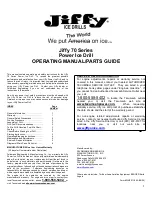
6 — English
INSTALLING/REMOVING BATTERY PACK
See Figure 3, page 9 (R82005).
See Figure 3, page 10 (R82230).
To install,
lock the switch trigger and insert the battery
pack.
OPERATION
INSTALLING/REMOVING BITS
See Figures 4 - 5, page 9.
The arrows on the keyless chuck indicate which direction
to rotate the chuck sleeve to tighten or release the drill bit.
Do not use a wrench to tighten or loosen the chuck jaws.
To install bits:
Lock the switch trigger and remove the
battery pack.
Open or close the chuck jaws until the opening is slightly
larger than the bit size you intend to use.
Raise the front of the drill slightly and insert the drill bit.
WARNING:
Make sure to insert the drill bit straight into the chuck
jaws. Do not insert the drill bit into the chuck jaws
at an angle then tighten. This could cause the drill
bit to be thrown from the drill, resulting in possible
serious personal injury or damage to the chuck.
WARNING:
Do not hold the chuck sleeve with one hand and
use the power of the drill to tighten the chuck
jaws on the drill bit. The chuck sleeve could slip
in your hand, or your hand could slip and come in
contact with the rotating drill bit. This could cause
an accident resulting in serious personal injury.
To remove bits
: Lock the switch trigger and open the
chuck jaws.
TWO SPEED GEAR TRAIN (HI-LO SWITCH)
See Figure 6, page 9.
Select
LO (1)
speed for applications requiring higher
power and torque.
Select
HI (2)
speed for fast drilling or driving applications.
NOTE:
Operating at low speeds under constant usage may
cause the tool to become overheated. If this occurs, cool
the tool by running it without a load and at full speed.
NOTICE:
Never change speeds while the tool is running.
Failure to obey this caution could result in serious
damage to the drill.
ADJUSTING TORQUE
See Figure 6, page 9.
Rotate the adjustment ring to the proper torque setting for
the type of material and size of screw you are using.
• 1 - 3
For driving small screws
• 4 - 7
For driving screws into soft material
• 8 - 11
For driving screws into soft and hard materials
• 12 - 15 For driving screws into hard wood
• 16 - 17 For driving large screws
•
For heavy drilling
DRILLING/DRIVING SCREWS
See Figures 7 - 8, page 9.
Check the direction of rotation selector for the correct
setting (forward or reverse).
Use
LO (1)
speed for high torque applications and
HI (2)
speed for fast drilling or driving applications. Refer
to
Two-Speed Gear Train
and
Adjusting Torque
.
Secure the workpiece in a vise or with clamps to keep it
from turning as the bit rotates.
Hold the drill firmly and place the bit at the point to be
drilled, or where the screw is to be driven.
WARNING
:
Do not drive a screw where there is likely to be
hidden wiring behind the surface. Contact with a
“live” wire will make exposed metal parts of the tool
“live” and possibly shock the operator. If you must
drive a screw where hidden wire may be present,
always hold tool by insulated gripping surfaces
(handle) when performing the operation to prevent
a shock to the operator.
Depress the switch trigger to start the drill.
Move the bit into the workpiece, applying only enough
pressure to keep the bit cutting or driving the screw. Do
not force the drill or apply side pressure to elongate a
hole. Let the tool do the work.
R82005 DRILL/DRIVER
Make sure the latch on the back of the battery pack snaps
into place and the battery pack is secured in the product
before beginning operation.
To remove,
depress the latch.
Summary of Contents for R82005
Page 23: ...NOTES...







































